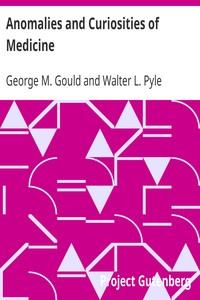Read this ebook for free! No credit card needed, absolutely nothing to pay.
Words: 394843 in 57 pages
This is an ebook sharing website. You can read the uploaded ebooks for free here. No credit cards needed, nothing to pay. If you want to own a digital copy of the ebook, or want to read offline with your favorite ebook-reader, then you can choose to buy and download the ebook.


: Anomalies and Curiosities of Medicine by Gould George M George Milbrey Pyle Walter L Walter Lytle - Medicine Anecdotes; Abnormalities Human Medicine
ANOMALIES AND CURIOSITIES OF MEDICINE.
GENETIC ANOMALIES.
Menstruation has always been of interest, not only to the student of medicine, but to the lay-observer as well. In olden times there were many opinions concerning its causation, all of which, until the era of physiologic investigation, were of superstitious derivation. Believing menstruation to be the natural means of exit of the feminine bodily impurities, the ancients always thought a menstruating woman was to be shunned; her very presence was deleterious to the whole animal economy, as, for instance, among the older writers we find that Pliny remarks: "On the approach of a woman in this state, must will become sour, seeds which are touched by her become sterile, grass withers away, garden plants are parched up, and the fruit will fall from the tree beneath which she sits." He also says that the menstruating women in Cappadocia were perambulated about the fields to preserve the vegetation from worms and caterpillars. According to Flemming, menstrual blood was believed to be so powerful that the mere touch of a menstruating woman would render vines and all kinds of fruit-trees sterile. Among the indigenous Australians, menstrual superstition was so intense that one of the native blacks, who discovered his wife lying on his blanket during her menstrual period, killed her, and died of terror himself in a fortnight. Hence, Australian women during this season are forbidden to touch anything that men use. Aristotle said that the very look of a menstruating woman would take the polish out of a mirror, and the next person looking in it would be bewitched. Frommann mentions a man who said he saw a tree in Goa which withered because a catamenial napkin was hung on it. Bourke remarks that the dread felt by the American Indians in this respect corresponds with the particulars recited by Pliny. Squaws at the time of menstrual purgation are obliged to seclude themselves, and in most instances to occupy isolated lodges, and in all tribes are forbidden to prepare food for anyone save themselves. It was believed that, were a menstruating woman to step astride a rifle, a bow, or a lance, the weapon would have no utility. Medicine men are in the habit of making a "protective" clause whenever they concoct a "medicine," which is to the effect that the "medicine" will be effective provided that no woman in this condition is allowed to approach the tent of the official in charge.
Empiricism had doubtless taught the ancient husbands the dangers of sexual intercourse during this period, and the after-results of many such connections were looked upon as manifestations of the contagiousness of the evil excretions issuing at this period. Hence at one time menstruation was held in much awe and abhorrence.
On the other hand, in some of the eastern countries menstruation was regarded as sacred, and the first menstrual discharge was considered so valuable that premenstrual marriages were inaugurated in order that the first ovum might not be wasted, but fertilized, because it was supposed to be the purest and best for the purpose. Such customs are extant at the present day in some parts of India, despite the efforts of the British Government to suppress them, and descriptions of child-marriages and their evil results have often been given by missionaries.
As the advances of physiology enlightened the mind as to the true nature of the menstrual period, and the age of superstition gradually disappeared, the intense interest in menstruation vanished, and now, rather than being held in fear and awe, the physicians of to-day constantly see the results of copulation during this period. The uncontrollable desire of the husband and the mercenary aims of the prostitute furnish examples of modern disregard.
The anomalies of menstruation must naturally have attracted much attention, and we find medical literature of all times replete with examples. While some are simply examples of vicarious or compensatory menstruation, and were so explained even by the older writers, there are many that are physiologic curiosities of considerable interest. Lheritier furnishes the oft-quoted history of the case of a young girl who suffered from suppression of menses, which, instead of flowing through the natural channels, issued periodically from vesicles on the leg for a period of six months, when the seat of the discharge changed to an eruption on the left arm, and continued in this location for one year; then the discharge shifted to a sore on the thumb, and at the end of another six months again changed, the next location being on the upper eyelid; here it continued for a period of two years. Brierre de Boismont and Meisner describe a case apparently identical with the foregoing, though not quoting the source.
Haller, in a collection of physiologic curiosities covering a period of a century and a half, cites 18 instances of menstruation from the skin. Parrot has also mentioned several cases of this nature. Chambers speaks of bloody sweat occurring periodically in a woman of twenty-seven; the intervals, however, were occasionally but a week or a fortnight, and the exudation was not confined to any one locality. Van Swieten quotes the history of a case of suppression of the menstrual function in which there were convulsive contractions of the body, followed by paralysis of the right arm. Later on, the patient received a blow on the left eye causing amaurosis; swelling of this organ followed, and one month later blood issued from it, and subsequently blood oozed from the skin of the nose, and ran in jets from the skin of the fingers and from the nails.
D'Andrade cites an account of a healthy Parsee lady, eighteen years of age, who menstruated regularly from thirteen to fifteen and a half years; the catamenia then became irregular and she suffered occasional hemorrhages from the gums and nose, together with attacks of hematemesis. The menstruation returned, but she never became pregnant, and, later, blood issued from the healthy skin of the left breast and right forearm, recurring every month or two, and finally additional dermal hemorrhage developed on the forehead. Microscopic examination of the exuded blood showed usual constituents present. There are two somewhat similar cases spoken of in French literature. The first was that of a young lady, who, after ten years' suppression of the menstrual discharge, exhibited the flow from a vesicular eruption on the finger. The other case was quite peculiar, the woman being a prostitute, who menstruated from time to time through spots, the size of a five-franc piece, developing on the breasts, buttocks, back, axilla, and epigastrium. Barham records a case similar to the foregoing, in which the menstruation assumed the character of periodic purpura. Duchesne mentions an instance of complete amenorrhea, in which the ordinary flow was replaced by periodic sweats.
Parrot speaks of a woman who, when seven months old, suffered from strumous ulcers, which left cicatrices on the right hand, from whence, at the age of six years, issued a sanguineous discharge with associate convulsions. One day, while in violent grief, she shed bloody tears. She menstruated at the age of eleven, and was temporarily improved in her condition; but after any strong emotion the hemorrhages returned. The subsidence of the bleeding followed her first pregnancy, but subsequently on one occasion, when the menses were a few days in arrears, she exhibited a blood-like exudation from the forehead, eyelids, and scalp. As in the case under D'Andrade's observation, the exudation was found by microscopic examination to consist of the true constituents of blood. An additional element of complication in this case was the occurrence of occasional attacks of hematemesis.
Hancock relates an instance of menstruation from the left breast in a large, otherwise healthy, Englishwoman of thirty-one, who one and a half years after the birth of the youngest child commenced to have a discharge of fluid from the left breast three days before the time of the regular period. As the fluid escaped from the nipple it became changed in character, passing from a whitish to a bloody and to a yellowish color respectively, and suddenly terminating at the beginning of the real flow from the uterus, to reappear again at the breast at the close of the flow, and then lasting two or three days longer. Some pain of a lancinating type occurred in the breast at this time. The patient first discovered her peculiar condition by a stain of blood upon the night-gown on awakening in the morning, and this she traced to the breast. From an examination it appeared that a neglected lacerated cervix during the birth of the last child had given rise to endometritis, and for a year the patient had suffered from severe menorrhagia, for which she was subsequently treated. At this time the menses became scanty, and then supervened the discharge of bloody fluid from the left breast, as heretofore mentioned. The right breast remained always entirely passive. A remarkable feature of the case was that some escape of fluid occurred from the left breast during coitus. As a possible means of throwing light on this subject it may be added that the patient was unusually vigorous, and during the nursing of her two children she had more than the ordinary amount of milk , which poured from the breast constantly. Since this time the breasts had been quite normal, except for the tendency manifested in the left one under the conditions given.
Cases of menstruation through the eyes are frequently mentioned by the older writers. Bellini, Hellwig, and Dodonaeus all speak of menstruation from the eye. Jonston quotes an example of ocular menstruation in a young Saxon girl, and Bartholinus an instance associated with bloody discharge of the foot. Guepin has an example in a case of a girl of eighteen, who commenced to menstruate when three years old. The menstruation was tolerably regular, occurring every thirty-two or thirty-three days, and lasting from one to six days. At the cessation of the menstrual flow, she generally had a supplementary epistaxis, and on one occasion, when this was omitted, she suffered a sudden effusion into the anterior chamber of the eye. The discharge had only lasted two hours on this occasion. He also relates an example of hemorrhage into the vitreous humor in a case of amenorrhea. Conjunctival hemorrhage has been noticed as a manifestation of vicarious menstruation by several American observers. Liebreich found examples of retinal hemorrhage in suppressed menstruation, and Sir James Paget says that he has seen a young girl at Moorfields who had a small effusion of blood into the anterior chamber of the eye at the menstrual period, which became absorbed during the intervals of menstruation. Blair relates the history of a case of vicarious menstruation attended with conjunctivitis and opacity of the cornea. Law speaks of a plethoric woman of thirty who bled freely from the eyes, though menstruating regularly.
Free books android app tbrJar TBR JAR Read Free books online gutenberg
More posts by @FreeBooks

: Burning Daylight by London Jack - Western stories; Women pioneers Fiction; Gold mines and mining Alaska Fiction; Bankruptcy Fiction; Oakland (Calif.) Fiction








